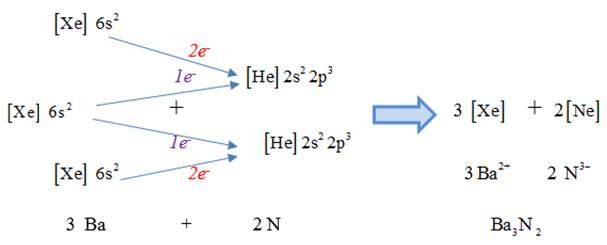
Interpretation:
The ionic bond formed between Barium and Nitrogen needs to be explained using electronic configuration diagram
Concept introduction:
Molecules are bound together by different types of bonds namely ionic and covalent. Ionic bonds are formed when there is complete transfer of electrons from one atom to another. These atoms either lose or gain electrons to become negatively or positively charged ions. The forces of attraction between these ions cause the ionic bond formation.
Electronic configuration of atoms depicts the distribution of electrons in its energy shells following certain set of rules laid down by Aufbau’s Principle.
Answer to Problem 71A
The ionic compound Barium
Explanation of Solution
Ionic bonds involve the transfer of electrons from one atom to the other. The metal atoms, an electrons donor, loses electrons to form a positively charged ion while the non-metal atoms, electron acceptor, gains electrons to form negatively charged ions. During the process of donating or gaining electrons, the atoms follow octet rule to attain a stable noble gas configuration.
Barium has
Nitrogen has atomic number of 7 with electronic configuration as
To form compound between Barium and Nitrogen, it can be seen that Barium ion is formed by losing two electrons to get Xenon configuration while Nitrogen ion is formed by gaining 3 electrons to get Neon configuration. To bring electrical neutrality, 3 atoms of Barium ion will combine with 2 atoms of Nitrogen ion to form a stable compound. In other words, 6 electrons donated by Barium will be taken up by 6 vacancies in Nitrogen.

The ionic compound Barium
Chapter 7 Solutions
Chemistry: Matter and Change
Additional Science Textbook Solutions
Organic Chemistry
Chemistry: A Molecular Approach
Introductory Chemistry (6th Edition)
General, Organic, and Biological Chemistry (3rd Edition)
Organic Chemistry (8th Edition)
 ChemistryChemistryISBN:9781305957404Author:Steven S. Zumdahl, Susan A. Zumdahl, Donald J. DeCostePublisher:Cengage Learning
ChemistryChemistryISBN:9781305957404Author:Steven S. Zumdahl, Susan A. Zumdahl, Donald J. DeCostePublisher:Cengage Learning ChemistryChemistryISBN:9781259911156Author:Raymond Chang Dr., Jason Overby ProfessorPublisher:McGraw-Hill Education
ChemistryChemistryISBN:9781259911156Author:Raymond Chang Dr., Jason Overby ProfessorPublisher:McGraw-Hill Education Principles of Instrumental AnalysisChemistryISBN:9781305577213Author:Douglas A. Skoog, F. James Holler, Stanley R. CrouchPublisher:Cengage Learning
Principles of Instrumental AnalysisChemistryISBN:9781305577213Author:Douglas A. Skoog, F. James Holler, Stanley R. CrouchPublisher:Cengage Learning Organic ChemistryChemistryISBN:9780078021558Author:Janice Gorzynski Smith Dr.Publisher:McGraw-Hill Education
Organic ChemistryChemistryISBN:9780078021558Author:Janice Gorzynski Smith Dr.Publisher:McGraw-Hill Education Chemistry: Principles and ReactionsChemistryISBN:9781305079373Author:William L. Masterton, Cecile N. HurleyPublisher:Cengage Learning
Chemistry: Principles and ReactionsChemistryISBN:9781305079373Author:William L. Masterton, Cecile N. HurleyPublisher:Cengage Learning Elementary Principles of Chemical Processes, Bind...ChemistryISBN:9781118431221Author:Richard M. Felder, Ronald W. Rousseau, Lisa G. BullardPublisher:WILEY
Elementary Principles of Chemical Processes, Bind...ChemistryISBN:9781118431221Author:Richard M. Felder, Ronald W. Rousseau, Lisa G. BullardPublisher:WILEY





